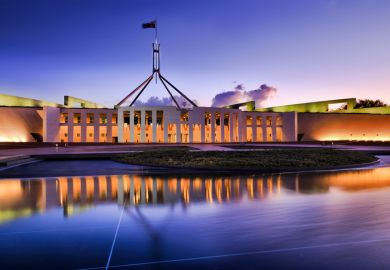Australia’s parliament has rubber-stamped controversial higher education fee and subsidy changes, successfully concluding the government’s six-year quest to legislate an overhaul of university funding.
It took the House of Representatives barely half an hour to approve the government’s Job-ready Graduates legislation, which had been passed by the Senate two weeks earlier, when parliament reconvened on 19 October.
The House agreed to an amendment reinstating a 10 per cent discount on student contribution amounts for people who paid their tuition fees upfront. The government had already approved amendments including a change to subsidies for some psychology courses and tweaks to the “special circumstances” maintaining students’ eligibility for government benefits if they failed more than half their subjects.
Education minister Dan Tehan said the legislation’s passage would boost university places for domestic students, bolster support for those from regional areas, cut fees in areas of expected job demand and encourage universities to work more closely with local businesses.
“From next year, up to 30,000 more Australians will get the opportunity to benefit from a higher education,” he said. “The bill also provides more money and more certainty for universities.
“University funding will grow by A$2 billion [£1.1 billion] to 2024 and the bill locks in indexation at pre-Covid rates for the next three years.”
Critics say the new arrangements will unnecessarily increase universities’ regulatory workload, force students to pay a higher overall proportion of the costs of degrees and penalise marginalised students who struggle with their courses. Opponents say the fee changes are unlikely to influence students’ choice of disciplines but will leave many saddled with unacceptable debt.
“It isn’t rich kids who will be discouraged from going to universities,” opposition leader Anthony Albanese told parliament. “It’s not my son or the son…or daughter of politicians.
“It is those young people out there today who might be the first in their family to finish school, who are thinking about whether they will take up that opportunity. They’re smart enough because they get the marks to get into university [but] for a working-class young person out there in the suburbs and the regional cities, a A$58,000 debt at the end of that process is a real penalty.”
Asked over the weekend whether the opposition would reverse the changes if it regained government – consequently making courses more expensive for students whose fees are set to decrease under the new arrangements – shadow education minister Tanya Plibersek would not answer directly but said Labor was “not in the business of increasing university fees”.
The Australian Academy of Technology and Engineering said it was “unconvinced” about the changes, citing estimates that universities’ costs of providing science and engineering degrees could increase by around 17 per cent per student. It said Macquarie University was considering closing 30 science and engineering courses next year while the Australian National University was jettisoning more than 120 science- and engineering-related jobs.
Meanwhile, the government has foreshadowed a change to funding settings that would increase the emphasis on applied research, with more of the A$800 million of grants handled by the Australian Research Council (ARC) to be redirected to its Linkage schemes.
Mr Tehan said the government would divert around A$30 million a year into Linkage grants. “Australia’s post-Covid economy recovery will require universities and businesses working together to commercialise research, turn ideas into jobs and deliver productivity gains and economic growth,” he said.
Register to continue
Why register?
- Registration is free and only takes a moment
- Once registered, you can read 3 articles a month
- Sign up for our newsletter
Subscribe
Or subscribe for unlimited access to:
- Unlimited access to news, views, insights & reviews
- Digital editions
- Digital access to THE’s university and college rankings analysis
Already registered or a current subscriber?








